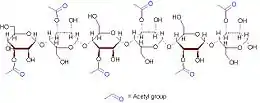Acémannane
L'acémannane est un isomère D de glycosaminoglycane, ou mucopolysaccharide, présent dans l’Aloe vera[2], aux propriétés médicinales duquel il contribue sensiblement[3] — notamment comme immunostimulant[4], voire, dans certaines conditions, comme anticancéreux[5] ou encore favorisant la cicatrisation[6]. Sa structure n'est pas homogène et consiste en un copolymère de monomères, généralement acétylés, de mannose, de glucose et de galactose avec une composition approximative de 31 unités β-(1,4)-mannose pour une unité β-(1,4)-glucose et une unité α-(1,6)-galactose[7] - [8].
| Acémannane | |

| |
| Exemple d'acémannane à six monomères | |
| Identification | |
|---|---|
| No CAS | |
| No ECHA | 100.122.396 |
| No CE | 600-942-8 |
| PubChem | 72041 |
| Écotoxicologie | |
| DL50 | > 80 mg·kg-1[1] (souris, i.v.) |
| CL50 | > 5 000 mg kg−1[1] |
| Unités du SI et CNTP, sauf indication contraire. | |
On a pu établir que l'acémannane incite, en complément de l'interféron γ IFNγ, les macrophages à sécréter du monoxyde d'azote NO, le facteur de nécrose tumorale TNF-α et l'interleukine 6[9] IL-6 ; il pourrait ainsi contribuer à lutter contre les infections virales. Ces trois cytokines sont connues pour induire des inflammations, et l'interféron est libéré en réponse aux viroses. Des études in vitro ont montré que l'acémannane inhibe la réplication du VIH[10], ce que les études in vivo n'ont cependant pas confirmé.
L'acémannane est utilisé pour le traitement du fibrosarcome chez le chien et le chat. L'administration d'acémannane favorise la nécrose des tumeurs et la survie des animaux[11].
Notes et références
- Acemannan Immunostimulant MSDS
- (en) Gerardo Daniel Sierra-García, Rocío Castro-Ríos, Azucena González-Horta, Jorge Lara-Arias et Abelardo Chávez-Montes, « Acemannan, an Extracted Polysaccharide from Aloe vera: A Literature Review », Natural Product Communications, vol. 9, no 8, , p. 1217-1221 (PMID 25233608, DOI 10.1177/1934578X1400900836, lire en ligne)
- (en) P. Chantarawaratit, P. Sangvanich, W. Banlunara, K. Soontornvipart et P. Thunyakitpisal, « Acemannan sponges stimulate alveolar bone, cementum and periodontal ligament regeneration in a canine class II furcation defect model », Journal of Periodontal Research, vol. 49, no 2, , p. 164-178 (PMID 23710575, DOI 10.1111/jre.12090, lire en ligne)
- (en) I. Tizard, « Use of immunomodulators as an aid to clinical management of feline leukemia virus-infected cats », Journal of the American Veterinary Medical Association, vol. 199, no 10, , p. 1482-1485 (PMID 1724773, lire en ligne)
- (en) G. K. King, K. M. Yates, P. G. Greenlee, K. R. Pierce, C. R. Ford, B. H. McAnalley et I. R. Tizard, « The effect of Acemannan Immunostimulant in combination with surgery and radiation therapy on spontaneous canine and feline fibrosarcomas », Journal of the American Animal Hospital Association, vol. 31, no 5, , p. 439-447 (PMID 8542364, DOI 10.5326/15473317-31-5-439, lire en ligne)
- (en) Suwimon Jettanacheawchankit, Siriruk Sasithanasate, Polkit Sangvanich, Wijit Banlunara et Pasutha Thunyakitpisal, « Acemannan Stimulates Gingival Fibroblast Proliferation; Expressions of Keratinocyte Growth Factor-1, Vascular Endothelial Growth Factor, and Type I Collagen; and Wound Healing », Journal of Pharmacological Sciences, vol. 109, no 4, , p. 525-531 (PMID 1724773, DOI 10.1254/jphs.08204FP, lire en ligne)
- (en) Y. Ni, D. Turner, K. M. Yates et I. Tizard, « Isolation and characterization of structural components of Aloe vera L. leaf pulp », International Immunopharmacology, vol. 4, no 14, , p. 1745-1755 (PMID 15531291, DOI 10.1016/j.intimp.2004.07.006, lire en ligne)
- (en) Sukumar Manna et Bill H. McAnalley, « Determination of the position of the O-acetyl group in a β-(1 → 4)-mannan (acemannan) from Aloe barbardensis Miller », Carbohydrate Research, vol. 241, , p. 317-319 (PMID 8472257, DOI 10.1016/0008-6215(93)80122-U, lire en ligne)
- (en) Linna Zhang et Ian R. Tizard, « Activation of a mouse macrophage cell line by acemannan: The major carbohydrate fraction from Aloe vera gel », Immunopharmacology, vol. 35, no 2, , p. 119-128 (PMID 8956975, DOI 10.1016/S0162-3109(96)00135-X, lire en ligne)
- (en) J. B. Kahlon, M. C. Kemp, R. H. Carpenter, B. H. McAnalley, H. R. McDaniel et W. M. Shannon, « Inhibition of AIDS virus replication by acemannan in vitro. », Molecular Biotherapy, vol. 3, no 3, , p. 127-135 (PMID 1768365)
- (en) C. Harris, K. Pierce, G. King, K. M. Yates, J. Hall et I. Tizard, « Efficacy of Acemannan in Treatment of Canine and Feline Spontaneous Neoplasms », Molecular Biotherapy, vol. 3, no 4, , p. 207-213 (PMID 1768373, lire en ligne)